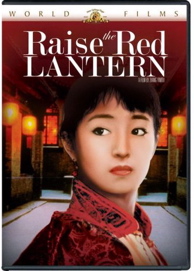| Release List | Reviews | Price Search | Shop | Newsletter | Forum | DVD Giveaways | Blu-Ray/ HD DVD | Advertise |
| Reviews & Columns |
|
Reviews DVD TV on DVD Blu-ray International DVDs Theatrical Reviews by Studio Video Games Features Collector Series DVDs Easter Egg Database Interviews DVD Talk TV DVD Talk Radio Feature Articles Columns Anime Talk DVD Savant HD Talk Horror DVDs Silent DVD
|
DVD Talk Forum |
|
|
| Resources |
|
DVD Price Search Customer Service #'s RCE Info Links |
|
Columns
|
 |
Raise the Red Lantern |

|
Raise the Red Lantern MGM / Fox 1991 / Color / 1:78 anamorphic widescreen / 125 min. / Da hong deng long gao gao gua / Street Date July 24, 2007 / 19.98 Starring Li Gong, Caifei He, Cuifen Cao, Jingwu Ma, Qi Zhao, Lin Kong, Jin Shuyuan, Zhihgang Cui, Chu Xiao Cinematography Lun Yang, Fei Zhao Art Direction Juiping Cao Film Editor Yuan Du Original Music Naoki Tachikawa, Jiping Zhao Written by Ni Zhen from a novel by Su Tong Produced by Fu-Sheng Chiu Directed by Yimou Zhang |
One of the more popular imports of the 1990s, Raise the Red Lantern invites western viewers into an exotic foreign world -- a patriarchal Chinese household in which wife-concubines compete for the favors of their husband, The Master. The beautifully photographed tale presents an alien and hostile marital arrangement that makes desirable women into powerless birds in gilded cages.
As the average American movie of the 1980s swung toward lightweight action pictures and tedious comedies, we saw fewer serious stories about the past. Zhang Yimou's Raise the Red Lantern was embraced by art-house audiences for its intelligence and novelty. Author Su Tong's characters never voice feminist sentiments, but the egregiously oppressive situation makes a universal statement about women's rights.
Economically de-classed, Songlian has little choice but to let her stepmother sell her into marriage, an arrangement that grants her few personal rights. The tiny courtyard of The Master's imposing mansion becomes Songlian's entire world. Her master wants only sex, entertaining companionship and sons; love does not factor into the equation. Servants use large paper lanterns to decorate the room of the wife with whom The Master will sleep. The women inevitably find subtle ways to compete with one othe. When The Master is with Songlian, wife #3 feigns sickness or sings to disturb their rest. Songlian responds with muted anger because she has no dignity and no options. Rituals restrict the behavior of the wives and complaining about conditions is useless. They naturally turn against each other.
Everything we see in Raise the Red Lantern is fascinating. The Master's wish is everything, and he can sample the favors of the servant Yan'er on the side. Songlian's efforts to assert her personal will are stymied by the discovery that her strongest ally is two-faced, and her sworn enemy is really a soul mate, a 'sister under the silk'. Opportunities exist to contact other men -- The Master's grown son and a doctor are regular visitors to the walled house -- but nobody even wants to talk about the penalty for infidelity. As it is, the wives' energies are spent dragging each other down, whether intentionally or by accident. The patriarchy thrives because the females are utterly powerless.
Director Zhang's formal compositions make practically every shot in Raise the Red Lantern a thing of beauty. The angles are so well chosen that camera moves become almost invisible. The Master remains a remote character. Although he's present in many scenes, we never get a clear look at his face. Songlian has no honest relationship with him, as the rituals leave no room for real personal interaction. The Master behaves in a kind but wholly authoritarian manner. With millions starving, what right have his pampered wives to complain?
Star Li Gong (billed in the west as Gong Li) has since been active internationally; she's appeared in The Emperor and the Assassin, Memoirs of a Geisha and Miami Vice. We first think that her Songlian will shed her tears and become a standard 'strong female' character, using her heart and mind to better her lot in life. Raise the Red Lantern chooses instead to be faithful to historical realities.
MGM /Fox's DVD of Raise the Red Lantern looks fine, with an unblemished, richly colored image. The enhanced transfer is listed as 2:35 on the box, but it looks more like 1:85 to these eyes. The language is Mandarin Chinese, with removable subtitles in English, Spanish and French. There are no extras, a choice that puts MGM's library titles at a distinct disadvantage in the film aficionado market. Buyers interested in quality foreign classics like Raise the Red Lantern expect the DVD experience to teach them something. At Criterion, a small DVD boutique or even Warners, the film would at least have some kind of commentary. The feature presentation is excellent, but DVD viewers expect more.
On a scale of Excellent, Good, Fair, and Poor,
Raise the Red Lantern rates:
Movie: Excellent
Video: Excellent
Sound: Excellent
Supplements: none
Packaging: Keep case
Reviewed: August 17, 2007
Reviews on the Savant main site have additional credits information and are more likely to be updated and annotated with reader input and graphics.
Review Staff | About DVD Talk | Newsletter Subscribe | Join DVD Talk Forum
Copyright © MH Sub I, LLC dba Internet Brands. | Privacy Policy | Terms of Use
|
| Release List | Reviews | Price Search | Shop | SUBSCRIBE | Forum | DVD Giveaways | Blu-Ray/ HD DVD | Advertise |





